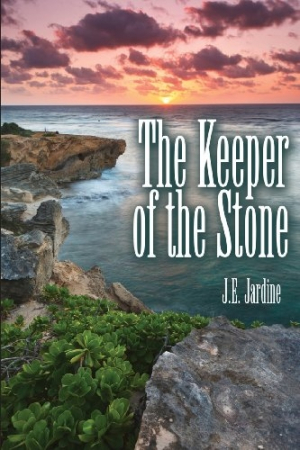The Keeper of the Stone
The narrative of this insightful novel creates a sense of the cognitive journey through vivid observations.
In The Keeper of the Stone, by J. E. Jardine, an engaging and contemplative modern parable, a disenchanted journalist is thrown into the role of a modern-day Siddhartha when a mysterious old woman gives him a stone for safekeeping.
Alan, a newspaper reporter, is plodding through life’s mundane gray in Seattle with Stella, his significant other, who is beginning to view their relationship as insignificant. One day, while working on a story at the courthouse, Alan thwarts a bombing. Still shell-shocked from his heroic act, he heads to the local bar where he encounters an old woman. She hands him a small stone and gives him a cryptic message: “Carry the stone close to your heart and in time its message will be revealed.”
Though Alan attempts to return to his gray existence, made even gloomier by Stella’s departure, what follows is a series of bizarre events that has Alan running for his life while struggling to understand what the stone represents and why he has been chosen as its keeper. His final challenges take place in Hawaii, where he encounters a sea turtle that reveals the answers about the stone.
The author’s strong characterizations offer a myriad of observations that expose the characters’ psyches, revealing a disconnect from feelings as they go through the motions of their lives: “Each had developed the ability to be emotionally opaque, the ability to avoid emotional transparence.” Alan’s disconnect and lack of appreciation for his existence is also evident after the incident at the courthouse: “So close to death one moment, now alive. But for what? The grey of the morning light remained.”
The observations, especially in the start of the book, quickly set the tone for the story and serve as a contrast to the final scenes: “It was grey in the city. Painfully grey.” The redundancy of Alan’s life is evident in the repetitive descriptions of weather, the physical and moral breakdown of society revealed through Stella’s infidelity, and the street outside the courthouse that is littered with derelicts, drug dealers, and streetwalkers.
The narrative also reflects the theme of transformation and mindfulness through the detailed mention of seemingly minor characters in the later parts of the book. Peter Sinclair, for example, is a character who appears briefly to move the plot forward; Jardine, however, offers numerous details about the character: “Peter Sinclair was a resident of the city, attending the local university and working part-time to make ends meet.” These in-depth observations support Alan’s journey, as everyone now serves a higher purpose rather than being anonymous and meaningless.
Rather than focusing on the powerful imagery offered by the sea turtle, Jardine incorporates many other images associated with holiness and Buddhist theology, such as the Buddha, an orange robe, and the fig tree in the concluding events. Though some readers may find this somewhat excessive, especially given the general message of enlightenment, overall, the mystery of the stone is well developed and compelling.
Reviewed by
Maya Fleischmann
Disclosure: This article is not an endorsement, but a review. The publisher of this book provided free copies of the book and paid a small fee to have their book reviewed by a professional reviewer. Foreword Reviews and Clarion Reviews make no guarantee that the publisher will receive a positive review. Foreword Magazine, Inc. is disclosing this in accordance with the Federal Trade Commission’s 16 CFR, Part 255.

